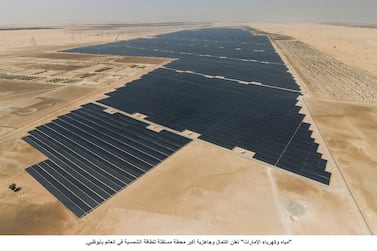A consortium led by Abu Dhabi National Energy Company (Taqa) and Masdar, in partnership with France’s EDF and JinkoPower, will develop the world’s largest solar power plant with a total capacity of 2 gigawatts in Abu Dhabi.
The project was awarded after a “rigorous procurement process [that] resulted in one of the most cost-competitive tariffs for solar PV energy”, the Emirates Water and Electricity Company said on Sunday.
The utility said the tariff was set at Dh4.97 fils per kilowatt hour ($1.35 cents/kWh) on a levelised cost of electricity basis”.
“The Al Dhafra Solar PV plant is a benchmark project for our nation and the global energy sector,” said Jasim Thabet, group chief executive and managing director at Taqa.
“The project’s low tariff and utilisation of best-in-class technology further demonstrate the feasibility of utility-scale renewable energy projects that are accelerating our nation’s progress on meeting the ambitious energy objectives outlined in the UAE Energy Strategy 2050.”
The project’s financial closure is set for the third quarter of this year, with power generation expected to begin in the first half of 2022 and full generation by the second half of 2022.
Once fully operational, the plant will increase Abu Dhabi’s solar power capacity to approximately 3.2 gigawatts.
The UAE is diversifying its energy mix and turning to solar and nuclear energy as it looks to free up hydrocarbons for export markets and generate up to 44 per cent of its energy from clean sources by 2050.
“By building one of the biggest solar plants in the world, adding up to their already significant renewable production capacity, the UAE is leading the renewable transition in the region,” said Sofia Bensaid, S&P Global Ratings infrastructure analyst.
Taqa and Masdar will own 60 per cent of Al Dhafra project, while the remaining 40 per cent will be held by EDF and China’s JinkoPower.
The project is expected to provide electricity to about 160,000 households across the UAE. It will be bigger than Taqa’s 1.2 gigawatt ‘Noor Abu Dhabi’ solar plant, the world’s largest operational single-site solar PV plant, according to EWEC.
“We are excited to be working with [the project’s partners] to realise the world’s largest single-site solar power plant in Abu Dhabi, building on our existing portfolio of world-class projects in the UAE, including Shams in Madinat Zayed in Abu Dhabi and the third phase of the Mohammed Bin Rashid Al Maktoum Solar Park in Dubai,” Mohamed Al Ramahi, chief executive of Masdar, said.
.@EWEC_AE announces its partners for the development of its 2 GW Al Dhafra Solar PV plant. The consortium of partners comprises @TAQAGroup, @Masdar, @edfenergy and JinkoPower. The project will be the world’s largest solar power plant. pic.twitter.com/G60fgM6cK7
— مكتب أبوظبي الإعلامي (@admediaoffice) July 26, 2020
Apart from the UAE, other countries such as Saudi Arabia, Jordan, Egypt and Morocco are also coming up with new renewable energy projects.
Saudi Arabia, the world’s largest oil exporter, plans to add 60 gigawatts of clean energy capacity to the national grid by 2030. Of this, 40GW will come from solar photovoltaic plants, 16 gigawatts from wind turbines and 2.7 gigawatts from concentrated solar power, according to the kingdom’s Ministry of Energy.
The country is developing the $500m (Dh1.83 billion) Dumat Al Jandal wind project in Al Jouf, which is expected to be completed in 2022.
A consortium that comprises Masdar and EDF is building the project.
Jordan, on the other hand, plans to increase its renewable energy capacity to 2.7 gigawatts by 2021.
The 117-megawatt Tafila wind project accounts for 12 per cent of renewable energy generation in Jordan and is owned by JWPC, in which Abu Dhabi’s Masdar holds a 50 per cent stake.
Dubai intends to generate 25 per cent of its energy requirements from renewable sources by 2030 and 75 per cent by 2050 as part of its clean energy drive. The Dubai Electricity and Water Authority is building the world’s largest solar energy park to help reduce the emirate’s reliance on natural gas and diversify its power sources.
The Mohammed bin Rashid Solar Park is expected to generate 5 gigawatts of electricity by 2030, helping boost investment by Dh50bn.
In April, Dewa signed a 25-year power purchase agreement with Saudi Arabia’s Acwa Power for the fifth phase of the Mohammed bin Rashid Al Maktoum solar park. The 900MW phase will be commissioned in stages starting from the third quarter of 2021, according to the utility.
Morocco, meanwhile, intends to generate 42 per cent of its power from renewable sources by 2020 and 52 per cent by 2030.
Last year, an international consortium including Masdar won a tender to construct an 800MW solar power plant in the country.
The ten largest solar power plants in the world
- Tengger Desert Solar Park, China – 1,547MW
- Sweihan Photovoltaic Independent Power Project, UAE – 1,177MW
- Yanchi Ningxia Solar Park, China – 1,000MW
- Datong Solar Power Top Runner Base, China – 1,070MW
- Kurnool Ultra Mega Solar Park, India – 1,000MW
- Longyangxia Dam Solar Park, China – 850MW
- Enel Villanueva PV Plant, Mexico – 828MW
- Kamuthi Solar Power Station, India – 648MW
- Solar Star Projects, US – 579MW
- Topaz Solar Farm / Desert Sunlight Solar Farm, US – 550MW
Source: Power Technology.com








